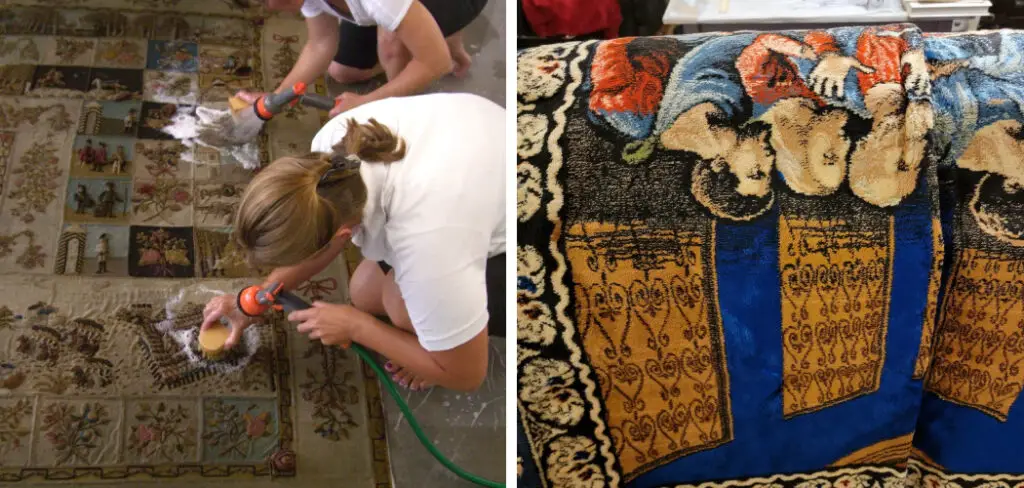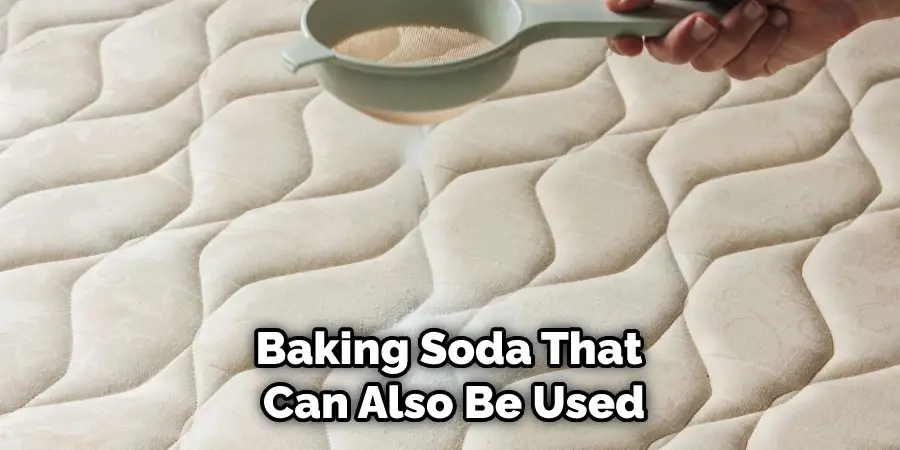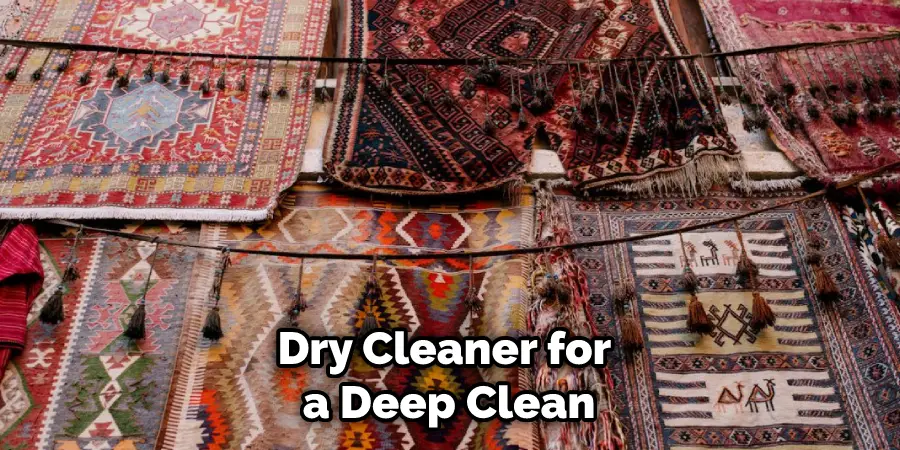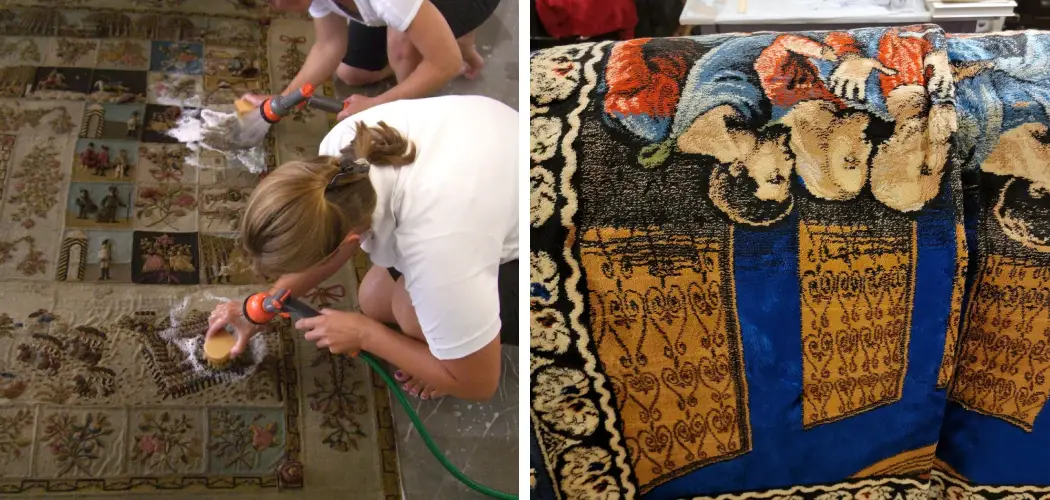Have you ever had a beautiful tapestry that’s been looking a little dingy lately? If so, then you know just how difficult it can be to clean and make sure that the fabric of your intricate design remains intact. With the right knowledge, however, cleaning and maintaining your treasured wall hanging doesn‘t have to be hard work.

In this blog post, we will provide all the tips and tricks on how to clean a tapestry necessary for giving your beloved tapestry a deep clean without damaging its artwork or fibers. Whether you own an antique tapestry or recently acquired a modern piece as home decor – make no mistake – these easy steps are guaranteed to get your gorgeous hand-woven art back on track!
Things to Remember While Cleaning
1. Fiber Type
Different fibers require different cleaning solutions, so it is important to make sure that you know what kind of fiber your tapestry is made of. Keep in mind that some fabrics may require special attention or even a professional cleaner.
2. How to Spot Clean
For light surface stains, use a damp cloth and a spot-cleaning solution (such as Woolite) to remove dirt and grime. Make sure you carefully dab the area instead of rubbing it back and forth in order to not cause damage to the fibers.
3. How to Dry Clean
If your tapestry is made with wool, silk, or natural fibers like cotton – you’ll need to take it to the dry cleaner for a deep clean. However, if you are working with an acrylic tapestry, then you can spot-clean it with a damp cloth.
4. Cleaner Alternatives
If you want to avoid using commercial cleaners on your tapestry, then there are other options like white vinegar and baking soda that can also be used to gently remove dirt and grime. It may take some trial and error to find the right combination for your fibers, but with patience and proper care, it’s possible.

Required Items
- Vacuum cleaner
- Soft cloths
- White vinegar
- Baking soda
- Spot cleaning solution (Woolite)
Types of Tapestry Fabrics
1. Wool
A wool tapestry is usually best taken to the dry cleaner for a deep clean. Make sure to check that your cleaning solution and method are gentle enough so as not to damage the fibers or artwork on the fabric.
2. Silk
Silk tapestries will require special attention, so it’s best to take them to the dry cleaner. Use a detergent that is specifically designed for silk fabrics in order to make sure you don‘t damage or discolor your fabric.
3. Acrylic
Acrylic tapestries are usually easier to clean than other natural fibers, so spot cleaning with a damp cloth and commercial cleaner may be enough.
10 Tips on How to Clean a Tapestry
1. Vacuum

Vacuum the tapestry using an upholstery attachment. This will help remove any dirt or dust that has built up over time. It is a good idea to vacuum the back of the tapestry as well. It will help to prevent any bugs or pests from nesting in the fibers.
2. Use a Soft Cloth
Using a soft, lint-free cloth, gently dab away any surface dirt and grime. Make sure not to rub too hard, as this can cause wear on your tapestry’s fabric over time. It is best practice to use a damp cloth for spot cleaning.
3. White Vinegar and Baking Soda
White vinegar and baking soda are natural alternatives that can be used to clean your tapestry. Mix equal parts of white vinegar and water into a spray bottle, then lightly mist the area you need to clean. Then sprinkle baking soda over the top and let it sit for at least 10 minutes before wiping it away.
4. Spot Cleaning Solutions
For tougher stains, use a spot-cleaning solution like Woolite or other purpose-made fabric cleaners that can be found in the laundry aisle of your local grocery store. Apply the solution directly to the stain and allow it to sit for a few minutes before wiping it away with a damp cloth.
5. How to Dry Clean Your Tapestry

If your tapestry is made from wool, silk, or natural fibers such as cotton – it’s best to take it to the dry cleaner for a deep clean. However, if you own an acrylic tapestry, then you can spot-clean it with a damp cloth.
6. How to Deep Clean Your Tapestry
If your tapestry needs a deep clean, you may need to consider having it professionally cleaned or washed by hand. It is important to note that some fabrics may require special attention or even a professional cleaner so make sure you read the care label before attempting any deep cleaning.
7. How to Hand Wash Your Tapestry
If you choose to hand wash your tapestry, use cold water and a mild detergent like Woolite. Fill a large enough container with the solution, and submerge your tapestry in it until all areas are saturated with the cleaner. Gently agitate the material until all of the dirt and grime is removed before draining and rinsing.
8. Air Dry
Once your tapestry is clean, it’s important to make sure you allow it ample time to air dry. Hang the tapestry outside in a shaded area with good ventilation so that it can dry properly. Do not put the tapestry in direct sunlight as this may cause the colors to fade.
9. Store the Tapestry
Find a cool, dark place to store your tapestry when not in use. Make sure you keep it away from any heat source, as this can cause it to become brittle and discolored. It is also important to keep the tapestry away from moisture or humidity, as this can cause mold or mildew to form.
10. Protection
It is best practice to regularly clean your tapestry by vacuuming and spot cleaning, as this will help to prevent dirt and grime from building up. Additionally, it’s a good idea to use fabric protectors or water repellents before using your tapestry in order to keep it looking its best.

Following these steps will help ensure that you can enjoy your tapestry for years to come!
These tips will help you to keep your tapestry clean and looking its best. With proper care and maintenance, your tapestry can last for many years. The key is to take the time to regularly vacuum and spot clean it in order to prevent dirt and grime from building up.
8 Maintenance Tips
- Vacuum your tapestry regularly to remove dust and dirt. How often you should vacuum will depend on the area where it hangs, but once every month or two is recommended. Tapestry hanging in less ventilated spaces should be vacuumed more frequently.
- Spot-clean any stains on your tapestry using a soft cloth and cold water. If the stain is particularly stubborn, use a mild detergent or mild soap with cold water instead. Never use hot water to treat a stain as this can set it permanently into the fabric.
- Hang the tapestry in a well-ventilated area to prevent the accumulation of dust and dirt on its surface. This will also help eliminate odors that could build up over time.
- When hanging your tapestry, make sure it is properly supported with enough tension so that it does not sag or become distorted. Tapestry hangers and rods are available for purchase online or in most home goods stores.
- Make sure that your tapestry is kept away from direct sunlight as much as possible to prevent fading of the colors. Too much exposure to UV rays can damage the fabric over time, so it’s important to keep your tapestry out of direct sunlight.
- If you need to store your tapestry for any reason, wrap it in a clean sheet or cloth and store it flat in an airtight container. Avoid storing the tapestry in plastic bags, as this can trap moisture and cause mold growth.
- If your tapestry needs to be washed, take it to a professional tapestry cleaner. This will ensure that your tapestry is properly cleaned and treated without damaging the fabric.
- Inspect your tapestry regularly for any signs of damage, such as tears or loose threads. If you notice any areas of concern, contact a professional to repair them before they become more serious. Taking care of your tapestry on a regular basis will help it last for many years to come.
Conclusion
Cleaning a tapestry can seem like a daunting task, however, with the proper tools and techniques on how to clean a tapestry, it does not have to be an overwhelming experience. Taking care of the tapestry is important in order to keep it looking and feeling like new. Vacuuming your tapestry regularly is essential, and you can spot-treat any stain with rubbing alcohol.
If you find yourself in need of cleaning deeper than that, hand wash the affected area or take it to a professional cleaner if needed. At the end of the day, taking care of your tapestry is up to you, and protecting its longevity comes down to making sure that you treat it with care. So get out your vacuum and test out the possibility of getting it professionally cleaned – there’s no better time than now!
About
Angela is the chief editor of Indoorense. She began her career as an interior designer before applying her strategic and creative passion to lifestyle and home.
She has close to 15 years of experience in creative writing and online content strategy for housekeeping and cleaning,home decorations as well as other efforts.
She loves her job and has the privilege of working with an extraordinary team. She lives with her husband, two sons, and daughter in Petersburg. When she’s not busy working she spent time with her family.

